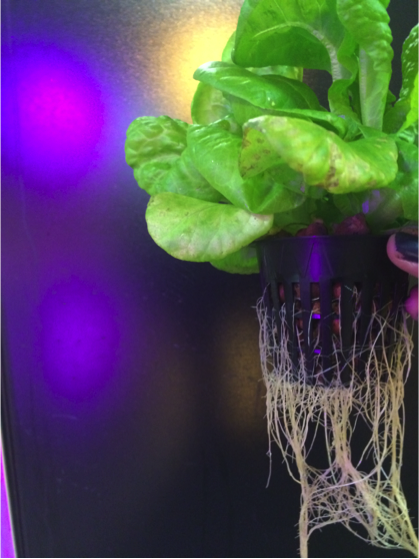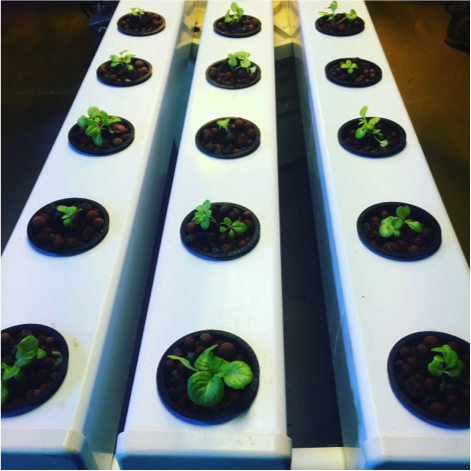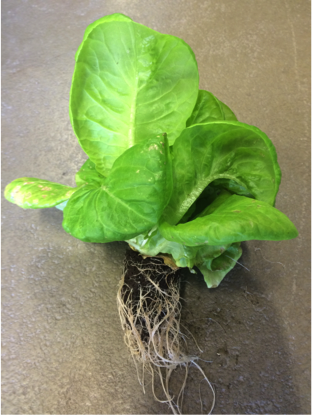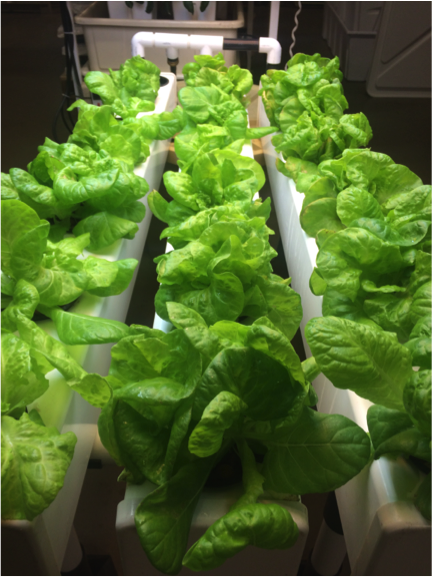 Hydroponic lettuce is surprisingly easy to grow and a great confidence builder for a beginner hydro enthusiast, myself included.
Hydroponic lettuce is surprisingly easy to grow and a great confidence builder for a beginner hydro enthusiast, myself included.
I work part time at Fifth Season Carrboro (one year this month!). When I first started working at the store, there were several young guys who were enthusiastic about hydro and took care of that part of the business. They were dialed in, and it was all a mystery to me. My husband was more enthusiastic than I was.
But as I watched the plants cycling in and out of the hydroponics displays, I wanted to know about these systems and how they produce beautiful produce all year long. I was given the opportunity to set up one of our systems on my own and grow something, while being mentored by store managers. With just a brief tutorial on setting up the system and adding the nutrients, I was out there in the land of hydro, growing a plant without soil, in water….
I chose to set up an AeroFlo system. It’s very straightforward and simple to understand. One person can set it up easily — I did. It’s easy to clean, easy to monitor, and best of all, in one month’s time, I harvested 18 heads of lettuce!
Here’s what I did:
First, I was smart and picked the easiest thing there is to grow in a hydroponic system, LETTUCE! Why set yourself up for failure on your very first try, am I right?! I chose the Tom Thumb variety because of its smaller size.
After deciding on the plant to grow, I started my seeds in seed plugs that we sell at Fifth Season. I like seed plugs because they are super easy to use. I germinated the seeds under fluorescent lights for a couple of weeks, then moved the seedlings into net cups lined with hydroton (clay pebbles used for hydroponics). The seed plugs sit nicely in the net cup, and the hydroton helps support and hydrate the seed plug.
Here is a seed plug at harvest time. You can see how beautiful and healthy the roots are!
I gave the seedlings a healthy start by adding to the water reservoir:
- Verde by Humbolt, to build the stem and root structure
- Armor SI, by General Organics- Silica strengthens the stems, aids in widening the leaves so that they may photosynthesize efficiently, and aids in the prevention of pests.
- Bush Doctor Kelp Me Kelp You, by Foxfarm, contains many growth promoting substances to accelerate the uptake of plant nutrients into roots, increase plant growth, and slow the progression of disease.
I learned that this ‘nutrient cocktail’ gives those tiny seedlings the best start, supporting the development of the roots and stems, helping prevent pests, and encouraging nutrient uptake, thus increasing the odds for strong plants.
We sell a lot of different varieties of nutrients at Fifth Season and all have their special place. After much reading and discussion, we all decided on using Canna products for my lettuce-feeding program. Canna is easy to understand, their website gives you straightforward calculations and they claim that their nutrients self-regulate the pH of the water for you. I found this to be true in my case. My pH stayed spot on throughout the process. I used the Aqua Vega part A and B, and it was simple to use.
I grew the lettuces under T5 fluorescent bulbs. I use T5 lights at home for my violets and seed starting already, and I really like them. They are efficient, do not put out a lot of heat, and plants love them. They do need to be close to the plants to be effective, but they are cool, so they don’t burn the plants.
I introduced my seedlings to the hydro tanks on October 6th, and on October 31st, I harvested 18 beautiful small heads of Tom Thumb lettuce, made an incredible Blue Cheese dressing, toasted walnuts in a mixture of butter, pure cane sugar, curry powder and smoked paprika, added some sliced red organic grapes and treated my coworkers and customers to a delicious hydroponic salad, grown only in water and nutrients!
I started arugula seeds just after the lettuce went in the hydro system. The day I harvested the lettuces, I cleaned the entire system with hydrogen peroxide, put the arugula seed plugs in the net cups, added some nutrients and in just a few more weeks, we will have an arugula salad! My hope is to bring one of these systems into my home as an addition to an outdoor garden and have greens growing all year long without the worry of pesky rabbits, worms, bugs, deer, you know…. all those things that want to eat what they think you are growing just for them!
We have a lot of great, informative technical information on this blog. But my hope is that with this simplified version of my experience, it will encourage others to think about having a hydro system in their home as well. The possibilities for growing fruits and vegetables indoors are endless! It’s FUN and its not that complicated.




Manny says
I am just starting my hydroponic set up. I have some success with strawberries and I am now trying lettuces. I have already germinated the Bibb lettuce seeds and they are about 3 inches long. I have also built a rail system to grow the lettuces. I am about to transplant to the seedlings to the 3-inch cup with the hydroton. My question is this: Do you transplant only the seedling to the cup or the entire peat plug?
ashley says
Transplant the entire plug into the cups with the hydroton – the roots will grow through the plugs.
Victor says
what height do you have the water?
I am trying to grow lettuce and they look weak currently.
Any tips would be welcome
ashley says
Water volume depends on the kind of system you are using (aeroponic, flood and drain, drip, etc). If your plants aren’t looking strong, it’s likely to be a nutrient or a pH problem. How are your pH and EC readings?
Hadi says
Hi Ashley, have you tried growing lollorosa lettuce ? I found it quite difficult to get it sprout. I use rockwool as the grow media, the seed’s shell has broken, then I put it under cool white fluorescent light; but I don’t see it grow and get bigger. I use RO water with no nutrients during germination. Need your advice please…thank you so much. I live in a tropical country with daily temperature of 28-31 C. I’ve tried romaine and it did well.
ashley says
Hadi,
One you have planted the seed in rockwool that has been presoaked in water ph’d to 5.5-5.8 put it under a humidly dome and let the seed do its thing as it germinates. Once you see a sprout coming out of the rockwool showing you its first set of leaves you can put it under the light.Then you will want to re-soak the rockwool every 5 days with ph’d water to 5.5-5.8. I would also consider trying seedling nutrient as rockwool is completely inert and has no nutrients. I would recommend Canna start as a great nutrient to give your new babies the proper does of food they need to grow up big and tasty. Hope this helps.
Cheers,
Gabrial
Hadi says
Hi Gabrial,
Thank you for the comment, I’d try as you recommended.
Will soaking the seeds in cool water before sowing will help speed up the germination ?
ashley says
Hi Hadi,
There is good research suggesting that soaking lettuce seeds in cool water for 16-24 hours in a well-lighted area before planting will significantly improve the chance of germination. But you need to soak them at least 16 hours for the soaking to have an effect. Good luck!
Tram says
Hello – I have a deep water culture system and have begun to grow lettuce.
At what point of growth can I transfer the lettuce to soil (the lettuce grew via fiberglass/seed cubes? And can I transfer the lettuce cubes to soil or somehow remove the roots from the cubes? All of my flowers and plants all died quickly once transferred to soil.
Help!
Thank you very much.
ashley says
Hello, If you try to start plants in a DWC you should transplant them as soon as you see roots. There is a difference between hydro and soil root zones. I haven’t seen very much success from taking established hydro plants to soil. Your best bet is to start them in soil if you want to finish in soil; otherwise grow hydroponically the whole way.
Gabby Croto says
How much water per minute or hour did you have running for the lettuce? My class and I made an aquaponic system and we need to know how long we should have our pump running for the water to flow through, without drowning them and killing them because they don’t have enough.
ashley says
Hi Gabby,
I usually set the timer to come on every 4 hours for 15 mins. Seems to allow the root zone to dry out but not kill the plant. Good luck with the aquaponics system – what a cool project for your class!
Johan says
Hi Ashley. My system has 12 pipes and they are 40 ft long respectively. Nutrient rich water continuously runs from the one side out the other side and back to the res. The first batch of butterhead lettuce has been in for 4 weeks and ready to harvest but now I’m seeing the tips of the leaves starting to die. I use FoxFarm 3-2-6. I tried to stay organic but now I don’t know what’s going on. Water temp is around 68f and ph between 5 and 6. Any advice? Find me on Facebook and look for Future Farms and Greeneries. Thanks.
María says
Hi
I’m from argentina and will appreciate so much your help on butter letucce germination stage.
I was trying it but I failed
I’m not sure if are moisture or temperature problems
I tried under 10 C and wet turba
Thank you very much
ashley says
Hi Maria, I’m not sure why your seeds failed. To germinate, seeds do need to be kept uniformly moist, and they do need warmer temperatures to come out of dormancy. Once germinated, lettuce likes cooler, rather than warmer temperatures, but if it is cold, the seeds won’t germinate.
Ilanh says
Hi,
I have build an NFT system using 4″ PVC pipes. The problem is that there is too big a distance from the bottom of the net pots to where the nutrient stream is flowing. This means that I need to grow the lettuce to a point where the roots are at least 3-4 inches long so that they can reach the water. My question is what do I do after they germinate to get roots that are long enough?
Kelly says
My husband is growing various types of lettuce in a DWC in our basement. They all grow and look great, but the texture is so very tender and becomes limp almost immediately after harvest. What are some possible causes? He wants to expand this DWC concept to a warehouse, but I am unsure of its success because the building will be quite warm in the summer.
ashley says
I would suggest that you integrate an adjustable drain valve into each NFT channel. Adjust the drain up, allowing the water to touch the net cup, and then adjusting down as the roots grow into the channel. Regards – Mike W.
Crimm says
I know this is old but, I’ll ask anyway: How much salad did you get out of those 18 heads? How many people did you feed?
I’m a long ways out from doing so, but some day I’d like to set up a system in my house to grow some of my own food. It would most likely just be me, but I have no idea how much to even consider planting for myself, if I wanted to eat a big salad 4 or 5 times a week.
I figured I’d have some plants on rotation, started at different times so I don’t just have one giant harvest.
ashley says
We harvested all of the lettuce at once and had a salad bar event at the store – not sure how many people it fed, but a lot. You could easily harvest a head every other day, or cull individual leaves from multiple plants as they grow. I would absolutely recommend succession planting so you always have new plants, medium sized-plants, and mature plants for harvesting, to always have a flow of ready-to-eat greens. Hope this helps!
Neil D'Costa says
I like to do the planting. this is something really new I have learned today. I would love to implement it.
DenisaA says
I totally agree, everyone should begin with growing lettuce when they start experimenting with hydroponics. It’s the easiest to grow and it will give anyone a boost of confidence to experiment with even more plants. Herbs are also easy to grow in hydroponic systems. I didn’t know about the AeroFlo system but it sounds awesome. For those who don’t have the budget, they can build a simple DWC in a plastic storage container.